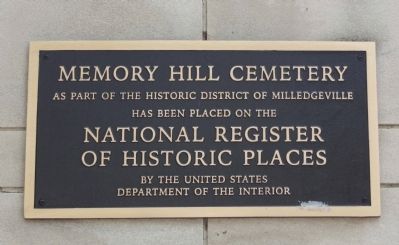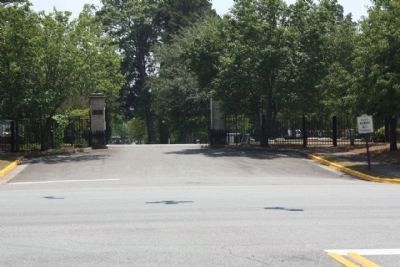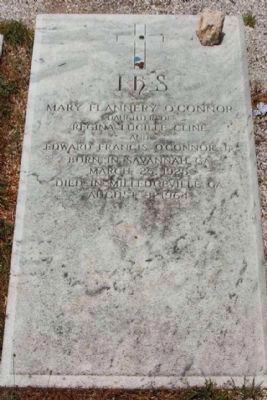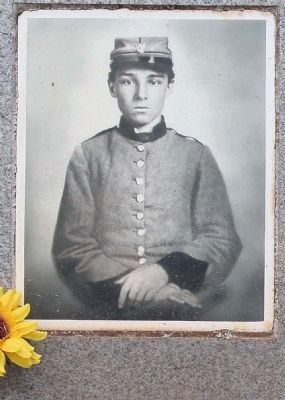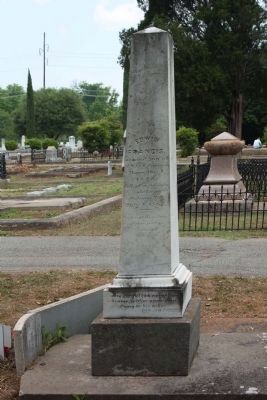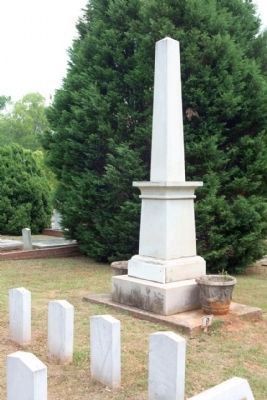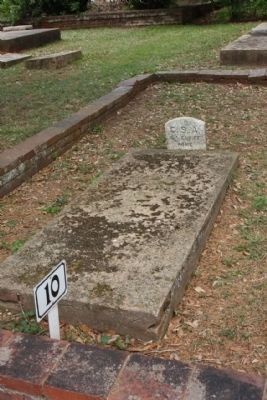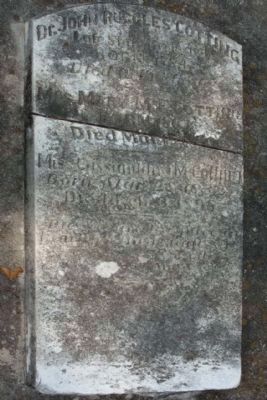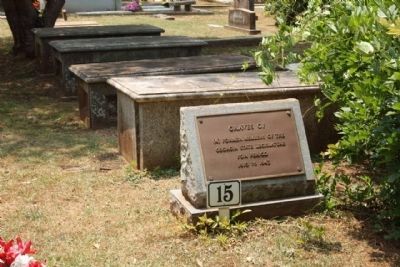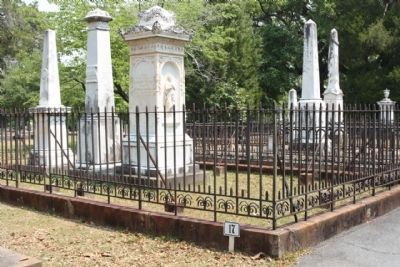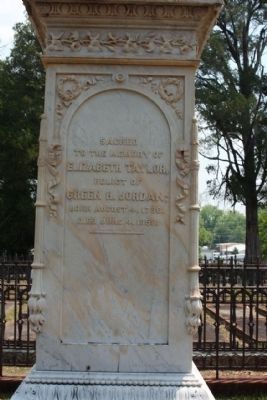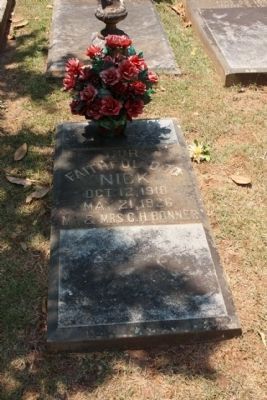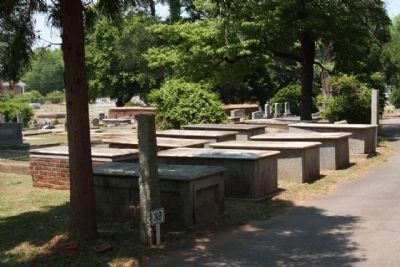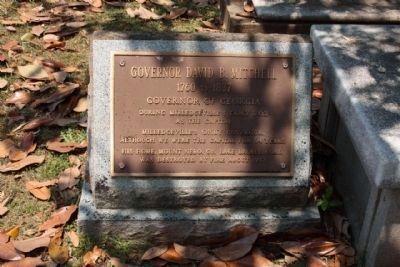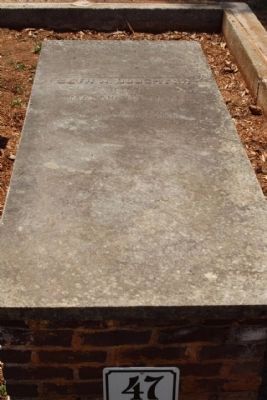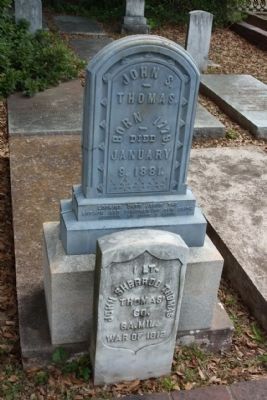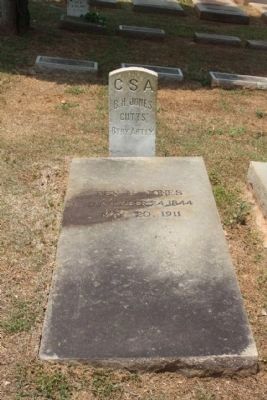Milledgeville in Baldwin County, Georgia — The American South (South Atlantic)
Memory Hill Cemetery
has been placed on the
National Register
Of Historic Places
By the United States
Department of the Interior
Topics. This historical marker is listed in this topic list: Cemeteries & Burial Sites.
Location. 33° 4.572′ N, 83° 13.75′ W. Marker is in Milledgeville, Georgia, in Baldwin County. Marker is on W. Franklin Street (U.S. 441) near S. Liberty Street, on the left when traveling west. Located between S. Wilkinson Street and S. Clarke Street. Touch for map. Marker is in this post office area: Milledgeville GA 31061, United States of America. Touch for directions.
Other nearby markers. At least 8 other markers are within walking distance of this marker. The Unknown Soldiers of Brown Hospital (about 500 feet away, measured in a direct line); Rear Admiral John W. Wilcox (about 600 feet away); The Methodist Church (about 600 feet away); Carl Vinson • Mary Green Vinson (about 600 feet away); Tomlinson Fort House (approx. 0.2 miles away); Lafayette's Tour (approx. ¼ mile away); St. Stephen's Episcopal Church (approx. ¼ mile away); The Old Governor's Mansion (approx. ¼ mile away). Touch for a list and map of all markers in Milledgeville.
Also see . . . ExploreSouthernHistory.com - Memory Hill Cemetery in Milledgeville, Georgia. The cemetery provides a quiet resting place for the remains of governors, legislators, Civil War soldiers, an Old West outlaw and even a consultant for the movie Gone With the Wind. The noted author Flannery O'Connor is at Memory Hill, as is the woman once called the "Little Georgia Magnet" for her alleged psychic abilities. (Submitted on May 11, 2011, by Mike Stroud of Bluffton, South Carolina.)
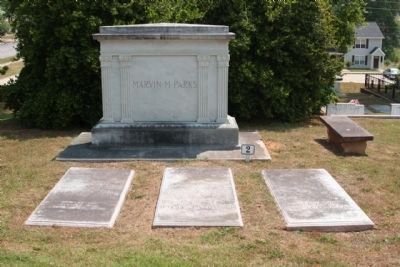
Photographed By Mike Stroud, May 10, 2011
4. Memory Hill Cemetery Marvin Parks
(Nov 29, 187 - Dec 29, 1926) A president of Georgia College, formerly Georgia
State College for Women, for 22-1/2 years. His gravestone mimics Parks Hall, located on
the college campus and named in his honor. (Memory Hill Cemetery)
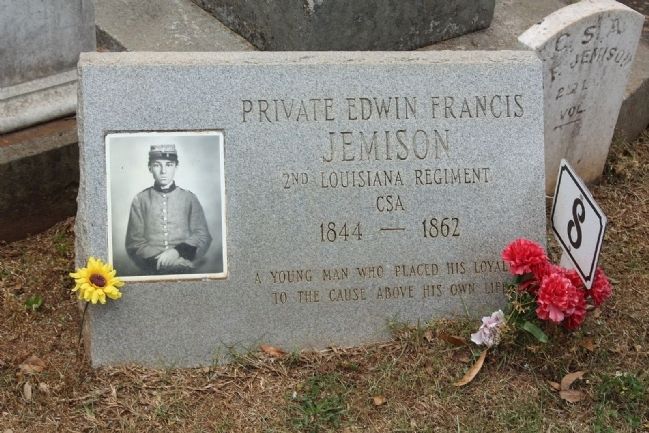
Photographed By Mike Stroud, 2011
5. Memory Hill Cemetery , Edwin Francis Jemison, b. December 1, 1844 d. July 1, 1862
Civil War Confederate Soldier. Born the 2nd son of R.W. and S.C. Jeminson in Milledgeville, Georgia, his family was living in Louisiana when the Civil War started. He joined the 2nd Louisiana Cavalry and fought under John B. Gordon during the Peninsula Campaign. At one point during the war, he transfered to and served with the 2nd Georgia Infantry. In July of 1862, he fought in the Battle of Malvern Hill, where he was killed. Edwin was only 17 years old.
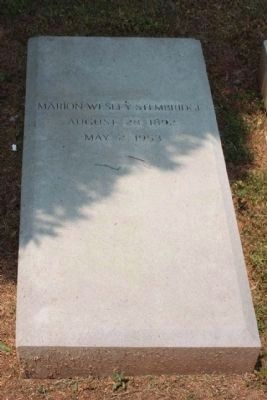
Photographed By Mike Stroud, May 10, 2011
8. Memory Hill Cemetery ,Marion Wesley Stembridge
(Aug 28, 1892-
May 2, 1953) On the day celebrating the
150th anniversary of the founding of Milledgeville,
Stembridge sought out, then shot and
killed, attorneys Marion Ennis and Steven
"Pete" Bivins. He then committed suicide. The
incident is described in the book and movie,
Paris Trout.(Memory Hill Cemetery tour)
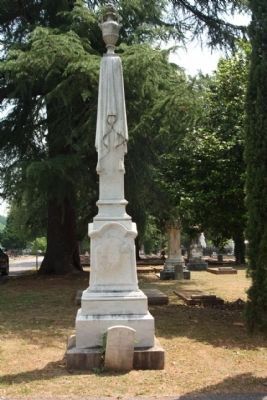
Photographed By Mike Stroud, May 10, 2011
9. Memory Hill Cemetery,
Lt. Col. John M. Brown (2nd Regiment Georgia
State Troops) (April 12, 1839-July 26,
1864) was the brother of Georgia Governor
Joseph Brown. He was wounded “while gallantly
leading his regiment in a charge on a
battery of Federal artillery” in Atlanta on July
22, 1864 and died in the Governor’s Mansion
in Milledgeville on July 26, 1864. (Memory Hill Cemetery tour)
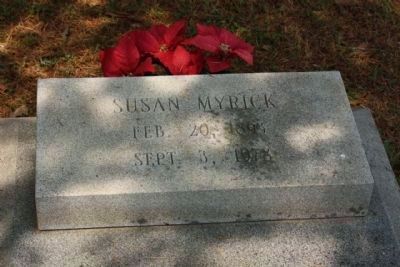
Photographed By Mike Stroud, May 10, 2011
10. Memory Hill Cemetery, Susan Myrick
(Feb 20, 1893-Sep 3, 1978) A
reporter for the Macon Telegraph starting in
1928. Among her most memorable columns
were those of 1939, when she became the
technical adviser for the filming of Gone With
the Wind upon the recommendation of Margaret
Mitchell. Myrick advised on Southern manners
and traditions during its filming. (Memory Hill Cemetery tour)
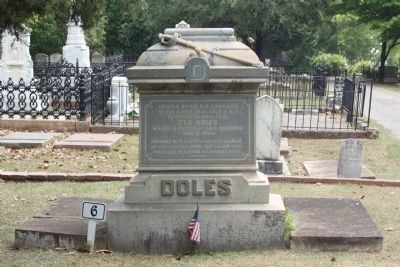
Photographed By Mike Stroud, May 10, 2011
11. Memory Hill Cemetery, General George Doles
(4th GA Vol. Infantry,Baldwin Blues) (May 14, 1830-June 2, 1864)This “diamond blue granite” monument was
unveiled July 25, 1894 at the annual reunion
of the 4th GA Regiment. Doles served gallantly
in battles in Virginia. At Spotsylvania, in
1864, his brigade suffered very high casualties.
Doles was criticized for his actions by
some newspapers. At the battle of Cold Harbor,
perhaps thinking of the criticism, he exposed
himself excessively to enemy fire. He
was shot through the chest and died the following
day. (Memory Hill Cemetery tour)
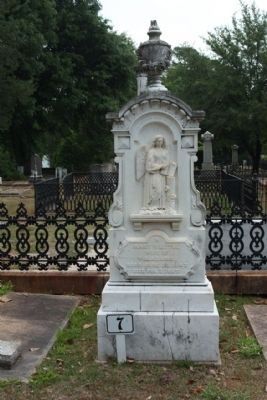
Photographed By Mike Stroud, May 10, 2011
12. Memory Hill Cemetery, Mary V. Little Adams
(Jun 20, 1847-Feb 2,
1867) This marker is carved by stone carver,
J. Artopé of Macon, and shows an angel holding
a quill and book, symbolizing the book of
life, and a stump with ivy, symbolizing a life
left unfinished when cut off by death. (Memory Hill Cemetery tour)
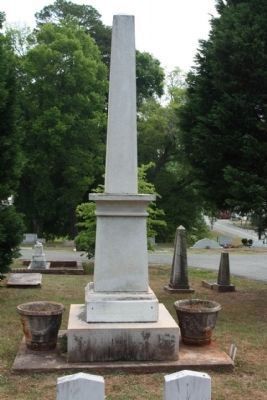
Photographed By Mike Stroud
13. Memory Hill Cemetery , "Our Unknown Confederate Dead"
The Soldiers’ Monument was erected in
1868. It is one of the first such Confederate
monuments in Georgia. It was erected to
commemorate Confederate dead in general
and, more specifically, to mark the graves of
unknown Confederate soldiers buried here who
had died in Brown Hospital in Milledgeville in
1864. (Memory Hill Cemetery tour)
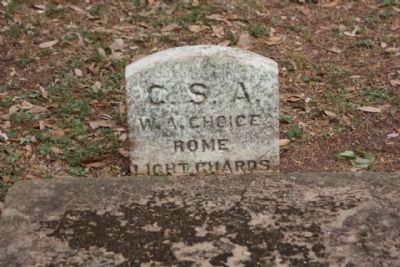
Photographed By Mike Stroud, May 10, 2011
15. Memory Hill Cemetery, William A. Choice C.S.A. Rome Light Guards
(died August 15, 1879)
was one of Atlanta's finest amateur actors of
the 1850s. He also drank heavily. Unprovoked
he shot and killed a man in Atlanta. His
only defense was insanity. His performance
during the trial won him an acquittal but confinement
to the Asylum in Milledgeville. (Memory Hill Cemetery tour)
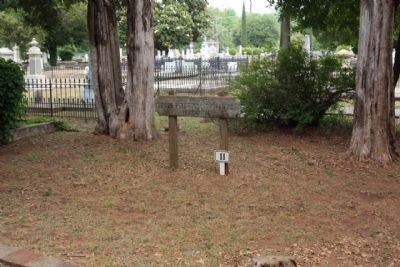
Photographed By Mike Stroud, May 10, 2011
17. Memory Hill Cemetery, Central State Hospital
(formerly the State Lunatic Asylum) On December 28,
1837, the Georgia State Legislature passed a
bill that created a "State Lunatic, Idiot, and
Epileptic Asylum." In 1842, the first patient
was admitted. By the 1960s the inpatient census
was over 12,000, making the asylum in
Milledgeville one of the largest mental hospitals
in the world at the time, leading to the
phrase “Gone to Milledgeville” to indicate insanity. (Memory Hill Cemetery tour)
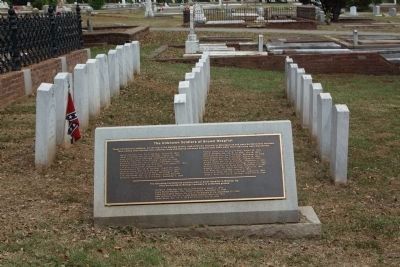
Photographed By Mike Stroud, May 10, 2011
18. Memory Hill Cemetery,The Unknown Soldiers of Brown Hospital
These Confederate soldiers, all serving in the Georgia Militia, died at Brown Hospital in Milledgeville and were buried at this location. Their names soon became lost, and they were concidered Unknown Soldiers until 2003 when their identies were discovered.
Marion Adkinson, Pvt., Co. F, 5th Regt., August 23, 1864
James T. Buckner, Pvt., Co. F, 9th Regt., August 31, 1864
Hugh Cannell, Pvt., Co. E, 12th Regt., September 3, 1864
Elisha B. Cape, Pvt., Co. A, 5th Regt., August 29, 1864
Edward M. Clark, Pvt., Co. F, 1st Bn., September 1, 1864
Ringold Commander, Pvt., Co. B, G.M.I. Cadet, August 27, 1864
J.R. Ellis, Pvt., Co. B, 2nd Bn., August 4, 1864
William Fussell, Pvt., Co. B, 2nd Regt., August 29, 1864
James M. Green, Pvt., Co. F, 9th Regt., August 31, 1864
Willis Harrell, Pvt., Co. I, 2nd Regt., September 7, 1864
J.M. Hutcherson, Pvt., Co. K, 6th Regt., August 24, 1864
William E. Joyner, Pvt., Co. F, 8th Regt., September 7, 1864
Thomas Judge, Pvt., Co. G, 2nd Regt., August 24, 1864 John Meadors, Pvt., Co. D, 1st Regt., July 28, 1864 Roland Mercer, Pvt., Co. F, 7th Regt., September 10, 1864 Owen Ramsey, Pvt., Co. I, 5th Regt., August 16, 1864 Aaron Rogers, Pvt., Co. C, 2nd Regt., August 22, 1864 William Tapley, Pvt., Co. H, 2nd Regt., September 3, 1864 Reddick Thorton, Pvt., Co. I, 11th Regt., August 27, 1864 William Tillory, Pvt., Co. D, 1st Regt., September 12, 1864 Green B. Turner, Pvt., Co. F, 6th Regt., August 18, 1864 J.M. Winn, Pvt., Co. F, 2nd Regt., August 2, 1864 Mordical W. Wood, Pvt., Co. I, 1st Regt., August 23, 1864 James, J. Wren, Pvt., Co. G, 2nd Regt.,September 8, 1864
———
The following Confederate soldiers died at Stout Hospital in Midway, Ga. They are buried at Midway Cemetery in unmarked graves.
William Etheridge, Pvt., Co. K, 57th Georgia, August 1, 1864 Frank Marion Herndon, Pvt., Phelan's Battery, September 17, 1864 Frank Washington Legare, Pvt., Co. E, 5th Georgia Militia, September 27, 1864 John Lemmons, Pvt., Co. H, 24th South Carolina, March 13, 1865 Henry Walker, Pvt., Co. E, 1st & 4th Missouri, July 30, 1864
Thomas Judge, Pvt., Co. G, 2nd Regt., August 24, 1864 John Meadors, Pvt., Co. D, 1st Regt., July 28, 1864 Roland Mercer, Pvt., Co. F, 7th Regt., September 10, 1864 Owen Ramsey, Pvt., Co. I, 5th Regt., August 16, 1864 Aaron Rogers, Pvt., Co. C, 2nd Regt., August 22, 1864 William Tapley, Pvt., Co. H, 2nd Regt., September 3, 1864 Reddick Thorton, Pvt., Co. I, 11th Regt., August 27, 1864 William Tillory, Pvt., Co. D, 1st Regt., September 12, 1864 Green B. Turner, Pvt., Co. F, 6th Regt., August 18, 1864 J.M. Winn, Pvt., Co. F, 2nd Regt., August 2, 1864 Mordical W. Wood, Pvt., Co. I, 1st Regt., August 23, 1864 James, J. Wren, Pvt., Co. G, 2nd Regt.,September 8, 1864
The following Confederate soldiers died at Stout Hospital in Midway, Ga. They are buried at Midway Cemetery in unmarked graves.
William Etheridge, Pvt., Co. K, 57th Georgia, August 1, 1864 Frank Marion Herndon, Pvt., Phelan's Battery, September 17, 1864 Frank Washington Legare, Pvt., Co. E, 5th Georgia Militia, September 27, 1864 John Lemmons, Pvt., Co. H, 24th South Carolina, March 13, 1865 Henry Walker, Pvt., Co. E, 1st & 4th Missouri, July 30, 1864
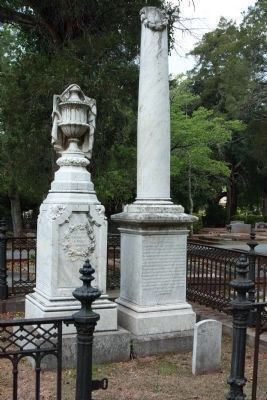
Photographed By Mike Stroud, May 10, 2011
19. Memory Hill Cemetery,Jesse Sanford Beall (Co. K 51st GA), at right
(October 18, 1840-Nov. 30, 1863) was Captain
of the “Albany Greys” in Semms’ Brigade.
He fought through the Virginia campaigns under
General Lee and was wounded at Chancellorsville.
At Chickamauga, while leading his
company in an assault, he fell mortally
wounded. He was buried on the field. His
remains were reburied here in March 1866.
His monument is a broken column symbolizing
his life was cut short and a wreath of oak
leaves symbolizing his military strength. (Memory Hill Cemetery tour)
Monument reads: Capt:Beall
Commanded the "Albany Greys' of the 51st Regiment Geo: Volunteers, Semms' Drigade: He fought through the Virginia Campaigns under GenL- Lee wounded at Chancellorsville- was at the Battle of Chickamauga- and while gallantly leading his company to an assukt upon one of the forts in front of Knoxville, fell mortally wounded on the 29th- and died on the 30th November 1863, he was buried on the field with military Honors- and his remains now rest beneath this monument erected to his memory by his father.
Monument reads: Capt:Beall
Commanded the "Albany Greys' of the 51st Regiment Geo: Volunteers, Semms' Drigade: He fought through the Virginia Campaigns under GenL- Lee wounded at Chancellorsville- was at the Battle of Chickamauga- and while gallantly leading his company to an assukt upon one of the forts in front of Knoxville, fell mortally wounded on the 29th- and died on the 30th November 1863, he was buried on the field with military Honors- and his remains now rest beneath this monument erected to his memory by his father.
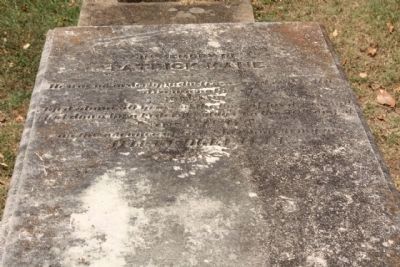
Photographed By Mike Stroud, May 10, 2011
20. Memory Hill Cemetery, Patrick Kane
(died November 20, 1864) was
not a Confederate soldier. However, he was
killed by Federal troops advancing on Milledgeville,
the only violent death during Sherman’s
capture and occupation of Milledgeville. (Memory Hill Cemetery tour)
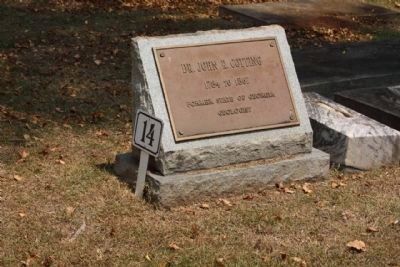
Photographed By Mike Stroud, May 10, 2011
21. Memory Hill Cemetery, Dr. John Ruggles Cotting, Former Georgia State Geologist
(1784-October 13, 1867) was born in Massachusetts and was a professor at Amherst and other colleges.
After 1810 he helped establish St. Stephens
church in Milledgeville. In the 1830s he was
engaged as the Georgia State Geologist and
began a statewide survey of Georgia. (Memory Hill Cemetery tour)
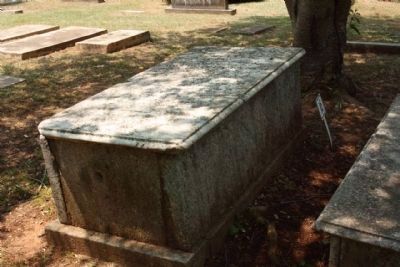
Photographed By Mike Stroud, May 10, 2011
24. Memory Hill Cemetery, Samuel Beckcom (Beckham)
(Nov. 21,1760-Nov. 2, 1825) served in the Revolutionary
War as a Lieutenant and later a Captain in
Colonel William Thompson’s Regiment of
South Carolina Rangers. He also commanded
a rifle company for the greater part of the war
under Gen. Elijah Clarke. He was wounded at
the Siege of Augusta. After the war in about
1802 he commanded militia at Fort Hawkins
(in Macon). (Memory Hill Cemetery tour)
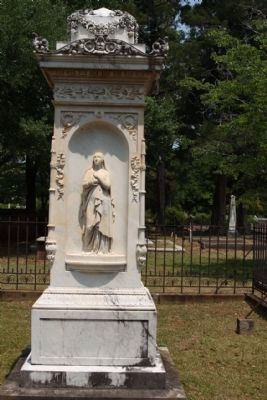
Photographed By Mike Stroud, May 10, 2011
26. Memory Hill Cemetery, Elizabeth Taylor Jordan
(August 4, 1796- June 4, 1858) This beautiful monument was created by Robert E. Launitz of New York who
is known as “the Father of Monumental Art in
America.” The marble is from Carrera, Italy. (Memory Hill Cemetery tour)
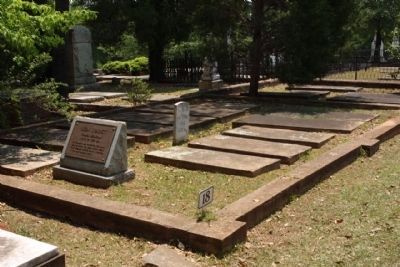
Photographed By Mike Stroud, May 10, 2011
28. Memory Hill Cemetery, Nathan C. Barnett
(June 28,1801- February 2, 1890) was Georgia Secretary
of State during the Civil War. When General
Sherman’s forces entered Milledgeville in
November 1864, Barnett hid the Great Seal of
the State of Georgia in a pig pen to keep it
from falling into the Federal army’s hands. (Memory Hill Cemetery tour)
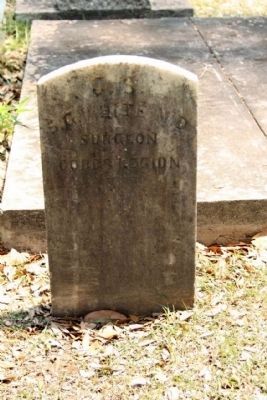
Photographed By Mike Stroud, May 10, 2011
29. Memory Hill Cemetery, Dr. Samuel Gore White
(1824-1877) served as Surgeon in Cobb's Legion, Georgia Volunteers,64th Regiment of Georgia Infantry,
C.S.A., Army of Northern Virginia. Dr. White
served as Assistant Surgeon in the U.S. Navy
during the Mexican War. (Memory Hill Cemetery tour)
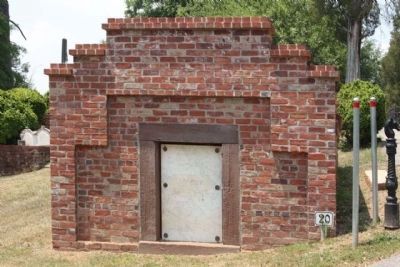
Photographed By Mike Stroud, May 10, 2011
30. Memory Hill Cemetery, Wm. Fish Family Vault
This partially subterranean
1840s vault contains the remains of
6 people. The story is that if you knock on the
door and ask Mr. Fish what he is doing in
there, you will get an answer. (Memory Hill Cemetery tour)
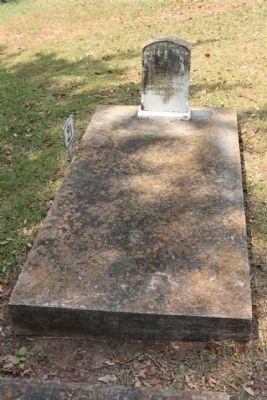
Photographed By Mike Stroud, 2011
31. Memory Hill Cemetery, Nancy Alston
(died 1878) was the trusted
nurse and former slave of Dr. Tomlinson Fort’s
family. The family thought so highly of her
that she was given Dr. Fort’s old office building
to live in upon the division of his estate. (Memory Hill Cemetery tour)
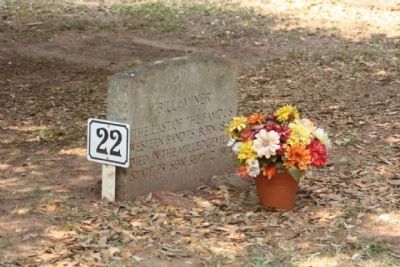
Photographed By Mike Stroud, May 10, 2011
32. Memory Hill Cemetery, Bill Miner (1843-Sep 2, 1914)
was a notorious stagecoach and train robber. The books, The Grey Fox and Bill Miner—Stagecoach and
Train Robber, describe his life. He died in the
State Prison on state route 22 west of Milledgeville
from which he had escaped several times. (Memory Hill Cemetery tour)
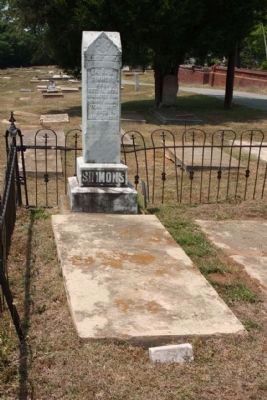
Photographed By Mike Stroud, May 10, 2011
33. Memory Hill Cemetery, Dr. Benjamin Judson Simmons
(October 16,1870-January 7, 1910) was the first black
physician in Milledgeville. He graduated from
Meharry Medical College in 1897. He was
very successful and recognized as a fine diagnostician.
He died of an unintentionally selfinflicted
gunshot wound.(Memory Hill Cemetery tour)
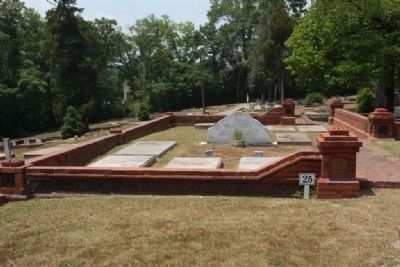
Photographed By Mike Stroud, May 10, 2011
34. Memory Hill Cemetery, McMillan family lot -
James W. McMillan
told people that they were living on a gold
mine of red clay. He owned a well-known brick
business in the late 1800s and created the
famous brick rope which surrounds the lot. (Memory Hill Cemetery tour)
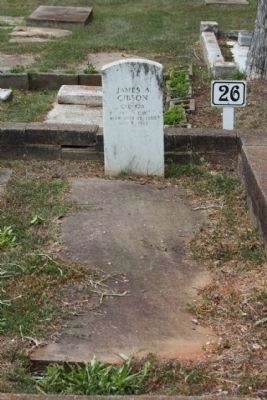
Photographed By Mike Stroud, May 10, 2011
35. Memory Hill Cemetery, Buffalo Soldiers -James A. Gibson
(Sept.13, 1880-May 5, 1945), a Buffalo Soldier, the name given to black Americans fighting in the Indian Wars of the 1870s, 1880s and the Spanish American War.
They fought in the Spanish American War,
charging up San Juan Hill with Teddy Roosevelt.
They later served in the Philippines. (Memory Hill Cemetery tour)
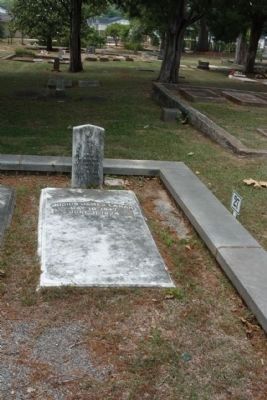
Photographed By Mike Stroud, May 10, 2011
36. Memory Hill Cemetery , Lucius James Lamar (Cadet, Co. B, GA. Military Institute)
(May 10, 1847-June 11,
1924) enlisted in the GMI cadet corps June
15, 1864 at the age of 17. Five months later
he was defending Milledgeville, with two companies
of cadets and some prisoners released
from the Milledgeville State Penitentiary,
against the army of General Sherman. Because
of overwhelming odds, the cadets retreated
from Milledgeville without offering resistance. (Memory Hill Cemetery tour)
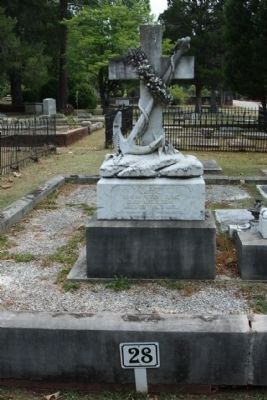
Photographed By Mike Stroud, May 10, 2011
37. Memory Hill Cemetery, Kate L. Cline
(died Aug. 1, 1884) gravestone
consists of an anchor, cross, ferns and a
wreath of flowers symbolizing well-grounded
hope (anchor) and victory in death (wreath)
with humility (ferns) and Christianity (cross). (Memory Hill Cemetery tour)
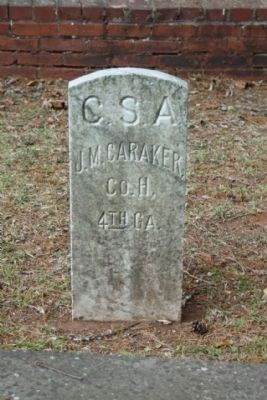
Photographed By Mike Stroud, May 10, 2011
38. Memory Hill Cemetery, Jacob M. Caraker (Co.. H, 4th GA, Baldwin Blues)
(February 11, 1838-November 2, 1907)
Elected Captain of the Baldwin Blues May 9,
1861. Before the war he was captain of the
guard at the state penitentiary in Milledgeville.
Severely wounded at the battle of Sharpsburg
on September 17, 1862, he resigned February
3, 1863. (Memory Hill Cemetery tour)
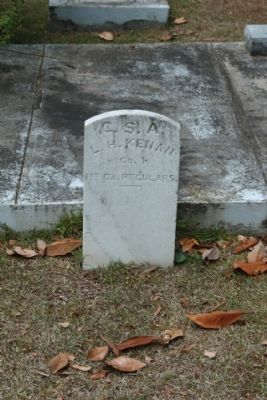
Photographed By Mike Stroud, May 10, 2011
39. Memory Hill Cemetery, Lewis Holmes Kenan (Co. I., 1st GA Reg.)
(Jan. 18, 1833-July 3, 1871) was wounded
July 7, 1864 at John’s Island, SC. He was
State Senator and Secretary of the Georgia
Senate. He was murdered on Hancock Street
by John R. Strother, who had recently married
Kenan’s father’s widow. Strother escaped justice
by being shipped out of town, by train,
concealed in a crate. (Memory Hill Cemetery tour)
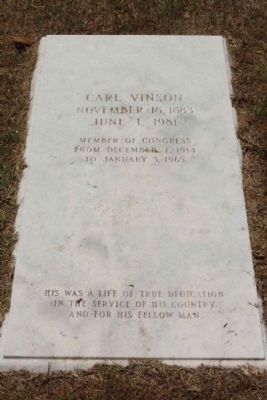
Photographed By Mike Stroud, May 10, 2011
40. Memory Hill Cemetery , Carl Vinson (Nov 18, 1883-Jun 1, 1981)
served in the US Congress for 50 years as a
representative from the 6th District of Georgia.
He is credited with being the father of the
"two ocean Navy" because he urged the creation
of the Pacific Fleet, and he created a 10-
year plan to build a strong navy and construct
ships starting in the early 1930s. It is his
foresight that helped prepare the U.S. for
World War II. An aircraft carrier, the U.S.S.
Carl Vinson, was named for him: the first time
a vessel was named for a living person. (Memory Hill Cemetery tour)
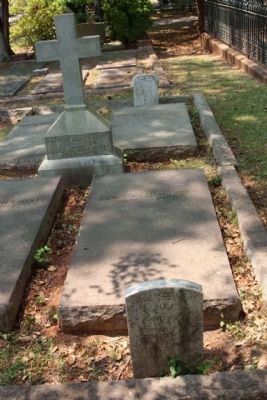
Photographed By Mike Stroud, May 10, 2011
41. Memory Hill Cemetery, James W. Herty
(August 14, 1838-December 20,
1876 - gravestone is incorrect) After graduation
from the University of New York, James
Herty joined the United States Navy as an assistant
surgeon. He was assigned to the USS
San Jacinto patrolling off the African coast.
Returning from African waters, the San Jacinto
intercepted the British ship HMS Trent carrying
Confederate diplomats to England. After
returning to port in Boston in November 1861,
Herty resigned from the US Navy and stated
his desire to join the Confederacy. He was
exchanged for a U.S. physician held by the
Confederacy. Herty was assigned to the CSS
Richmond and then the Rappahannock. He is
the only veteran in Memory Hill who honorably
served both the Confederacy and the United
States during the Civil War. (Memory Hill Cemetery tour)
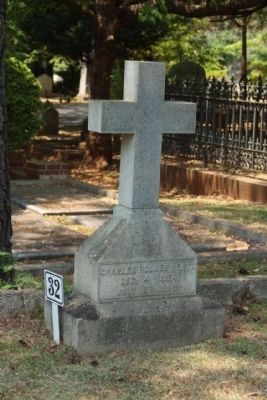
Photographed By Mike Stroud, May 10, 2011
42. Memory Hill Cemetery, Charles Holmes Herty
(Dec 4, 1867-Jul 27,
1938) Charles Holmes Herty was a noted researcher
and chemist. He also was University
of Georgia’s first football coach. He invented
a device that allowed young pines to mature
and reseed while allowing extraction of turpentine
or other products. In the 1930s, he
proved that high-quality newsprint and other
paper products could be made from Southern
pine, thereby greatly aiding the economy of
the South. It is for this achievement that most
Georgians hold him in highest esteem. Note
the pine tree planted at his head.(Memory Hill Cemetery tour)
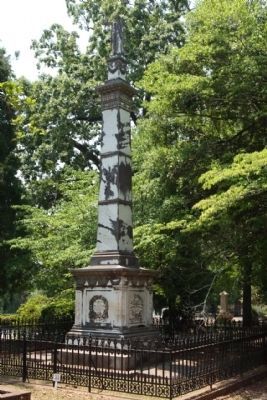
Photographed By Mike Stroud, May 10, 2011
43. Memory Hill Cemetery, Benjamin Jordan
(ca. 1793-October 11,
1856) was a wealthy plantation owner. The
monument was created by Robert E. Launitz
of New York, who also designed the similar
Pulaski Monument in Savannah. It was
erected in March 1858 at a cost of $20,000. It
is 37 feet tall not including the figure at the
top that represents Hope. (Memory Hill Cemetery tour)
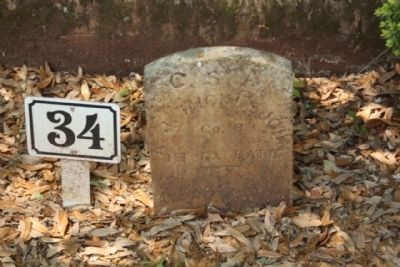
Photographed By Mike Stroud, May 10, 2011
44. Memory Hill Cemetery, Andrew J. Micklejohn (Co B. 1st. GA. Batt.)
(died Nov. 24, 1861) was the first local battle
casualty of the Civil War, having been killed
during the bombardment of Ft. Pickens, near
Pensacola, FL. His body was returned to Milledgeville
and buried in a ceremony that the entire city attended. (Memory Hill Cemetery tour)
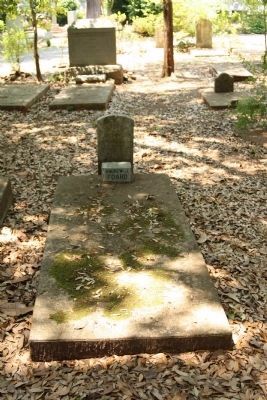
Photographed By Mike Stroud, May 10, 2011
46. Memory Hill Cemetery,Dr. Andrew J. Foard (died March 18, 1868)
This tombstone, erected in 1896, misspells the
name. "Foard" is correct. Dr. Foard was the
Medical Director of the Army of Tennessee. In
February 1865 he was promoted to Medical
Inspector of the armies and hospitals in the
States of Georgia, Florida, Alabama and Mississippi.
After the war he was a professor at
the Washington Medical College in Baltimore. (Memory Hill Cemetery tour)
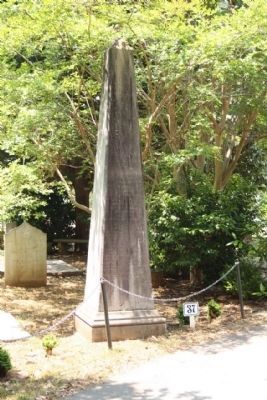
Photographed By Mike Stroud, May 10, 2011
47. Memory Hill Cemetery, Lucius Quintus Cincinnatus Lamar
(Jul 15, 1797-Jul 4, 1834) Judge of the Ocmulgee
Circuit and mentioned in J. F. Kennedy’s Profiles
in Courage. Lamar committed suicide. A
false legend relates that he had hanged an
innocent man and was remorseful. His
brother Mirabeau Buonaparte Lamar was the
second President of the Republic of Texas. (Memory Hill Cemetery tour)
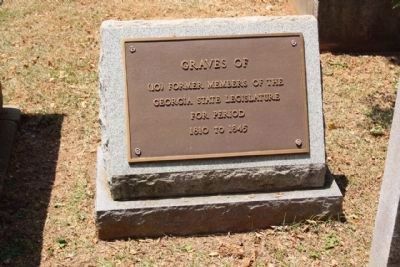
Photographed By Mike Stroud, May 10, 2011
49. Memory Hill Cemetery Legislators
Despite the bronze plaque, only
9 of these box markers are for legislators who
were serving when Milledgeville was the state
capital. Henry Denison (May 31, 1796-
October 31, 1819) was never a legislator or
politician. Born in Vermont, Denison was a
Milledgeville school teacher and poet. A sample
of his poetry was published in 1828 in the
book The Columbian Lyre. He also helped
found the Southern Recorder newspaper.
However, he died of fever before the first issue
was printed. (Memory Hill Cemetery tour)
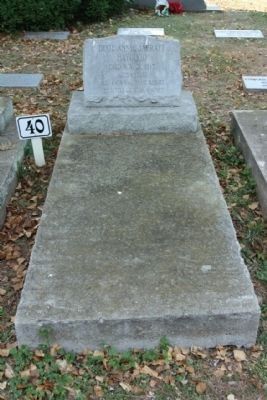
Photographed By Mike Stroud, May 10, 2011
51. Memory Hill Cemetery,
Dixie Haygood also known as Annie Abbott,
“The Little Georgia Magnet” (died
Nov. 21, 1915 age 54) performed for large
audiences and royalty throughout the world in
the 1890s. She was known as an “electric”
girl and spiritualist who, despite weighing only
96 pounds and being short in stature, had the
power to resist attempts by strong men to lift
her or push her backwards. Her act is still
sometimes performed by magicians and is
known as the “Annie Abbott” act. Charles
Haygood, (November 10, 1855-February 27,
1886), husband of Dixie Haygood and a Deputy
Sheriff, was shot twice at point blank
range in the chest, by Elias N. "Sam" Ennis
during a prohibition rally. (Memory Hill Cemetery tour)
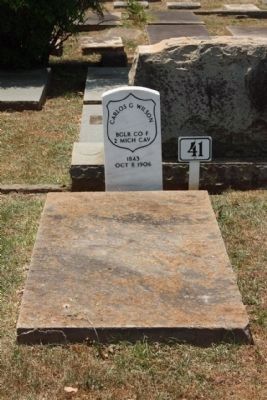
Photographed By Mike Stroud, May 10, 2011
52. Memory Hill Cemetery, Carlos Wilson
(1843-Oct 8,1906) was a bugler
in Company F, 2nd Michigan Cavalry in
the Union army. Like the other Union veterans
buried here, he came to Milledgeville after
the Civil War. Here he became an inventor,
patenting a Cotton Seed Planter and Guano
Distributing Machine. (Memory Hill Cemetery tour)
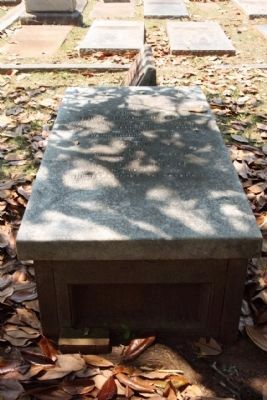
Photographed By Mike Stroud, May 10, 2011
53. Memory Hill Cemetery,
David Brydie Mitchell (Oct. 22, 1760-Apr.
22, 1837) served as governor of Georgia from
1809-1813 and 1815-1817, during which time
he passed an act to prevent dueling and set
up a system at the state penitentiary in Milledgeville
that was more than simple imprisonment
— teaching prisoners to learn a trade.
(Memory Hill Cemetery tour)
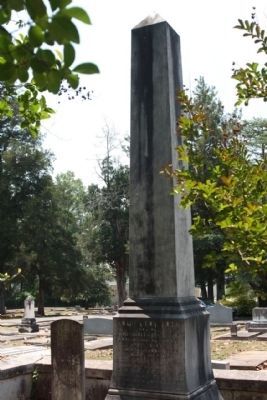
Photographed By Mike Stroud, May 10, 2011
55. Memory Hill Cemetery, Tomlinson Fort
(Jul 14, 1787-May 11, 1859)
This wounded War of 1812 veteran served in
the US House of Representatives (1827-1829)
and the Georgia state legislature (1818-1825).
He was a prominent physician and was instrumental
in creating the Georgia Lunatic Asylum
in 1837 and a Board of Physicians which licensed
doctors. His book, A Dissertation on
the Practice of Medicine, published in 1849,
contains some of the best-known medical
treatments of the day. Wilkes Flagg (buried
across the street at Flagg’s Chapel) (about
1801-Nov 13, 1878) was a slave who, prior to
the Civil War, bought his and his family’s freedom
from his owner, Dr. Tomlinson Fort, by
working after hours as a blacksmith. Their
freedom was kept secret, however, because of
the attitude against free blacks. After the war,
he built Flagg’s Chapel, which he also used for
instructing others in economic and social matters. (Memory Hill Cemetery tour)
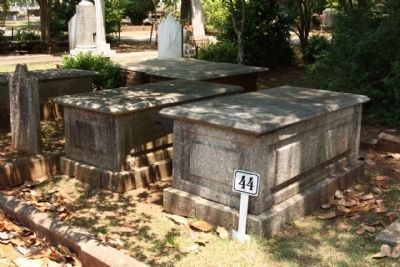
Photographed By Mike Stroud, May 10, 2011
56. Memory Hill Cemetery, John Marlor
(February 11, 1789- October
13, 1835) was the architect and builder of the
Masonic Hall on Hancock Street, as well as several
outstanding private homes. His marker
includes symbols of masons’ tools. (Memory Hill Cemetery tour)
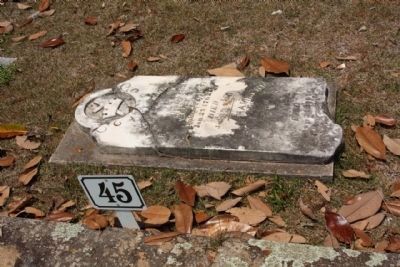
Photographed By Mike Stroud, May 10, 2011
57. Memory Hill Cemetery, Abner Hammond
(Jan. 25, 1762-Jul. 9,
1829) served as a Lieutenant and later a Captain
in the South Carolina Troops during the
Revolutionary War. He raised a volunteer company
and joined his brother at the Siege of Augusta
in 1781. He served as Georgia’s Secretary
of State from 1811 to 1823. (Memory Hill Cemetery tour)
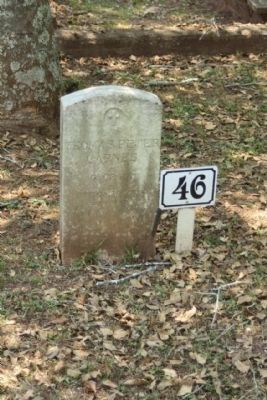
Photographed By Mike Stroud, May 10, 2011
58. Memory Hill Cemetery,Thomas Petters Carnes
(name on marker is
misspelled) (1762-May 5, 1822) served as a
colonel in the Maryland Line in the Revolutionary
War. He held various offices and judgeships,
and from 1793-1795, he was a member
of Congress. In 1806 he participated in determining
the location of the 35 degree of latitude
that separates Georgia from North Carolina
and Tennessee. Errors crept into the calculations.
As a result, the survey line runs
about four miles south of the actual 35th degree
line, thus making Georgia slightly smaller
than it ought to have been. Consequently
Chattanooga is in Tennessee rather than in
Georgia. Carnesville, GA was named for him. (Memory Hill Cemetery tour)
Credits. This page was last revised on November 15, 2018. It was originally submitted on May 11, 2011, by Mike Stroud of Bluffton, South Carolina. This page has been viewed 2,914 times since then and 58 times this year. Photos: 1, 2, 3, 4, 5, 6, 7. submitted on May 11, 2011, by Mike Stroud of Bluffton, South Carolina. 8, 9, 10, 11, 12, 13. submitted on May 12, 2011, by Mike Stroud of Bluffton, South Carolina. 14. submitted on May 22, 2011, by Mike Stroud of Bluffton, South Carolina. 15. submitted on May 12, 2011, by Mike Stroud of Bluffton, South Carolina. 16. submitted on May 22, 2011, by Mike Stroud of Bluffton, South Carolina. 17, 18, 19, 20, 21. submitted on May 12, 2011, by Mike Stroud of Bluffton, South Carolina. 22. submitted on May 22, 2011, by Mike Stroud of Bluffton, South Carolina. 23, 24. submitted on May 12, 2011, by Mike Stroud of Bluffton, South Carolina. 25. submitted on May 22, 2011, by Mike Stroud of Bluffton, South Carolina. 26. submitted on May 12, 2011, by Mike Stroud of Bluffton, South Carolina. 27. submitted on May 22, 2011, by Mike Stroud of Bluffton, South Carolina. 28, 29, 30. submitted on May 12, 2011, by Mike Stroud of Bluffton, South Carolina. 31, 32, 33, 34, 35, 36, 37, 38, 39, 40, 41, 42, 43, 44, 45, 46, 47, 48, 49, 50, 51, 52, 53, 54, 55, 56, 57, 58, 59, 60, 61. submitted on May 20, 2011, by Mike Stroud of Bluffton, South Carolina.
